Fast Food Industry Statistics 2024 By Demographics, Region, Products and Market Share
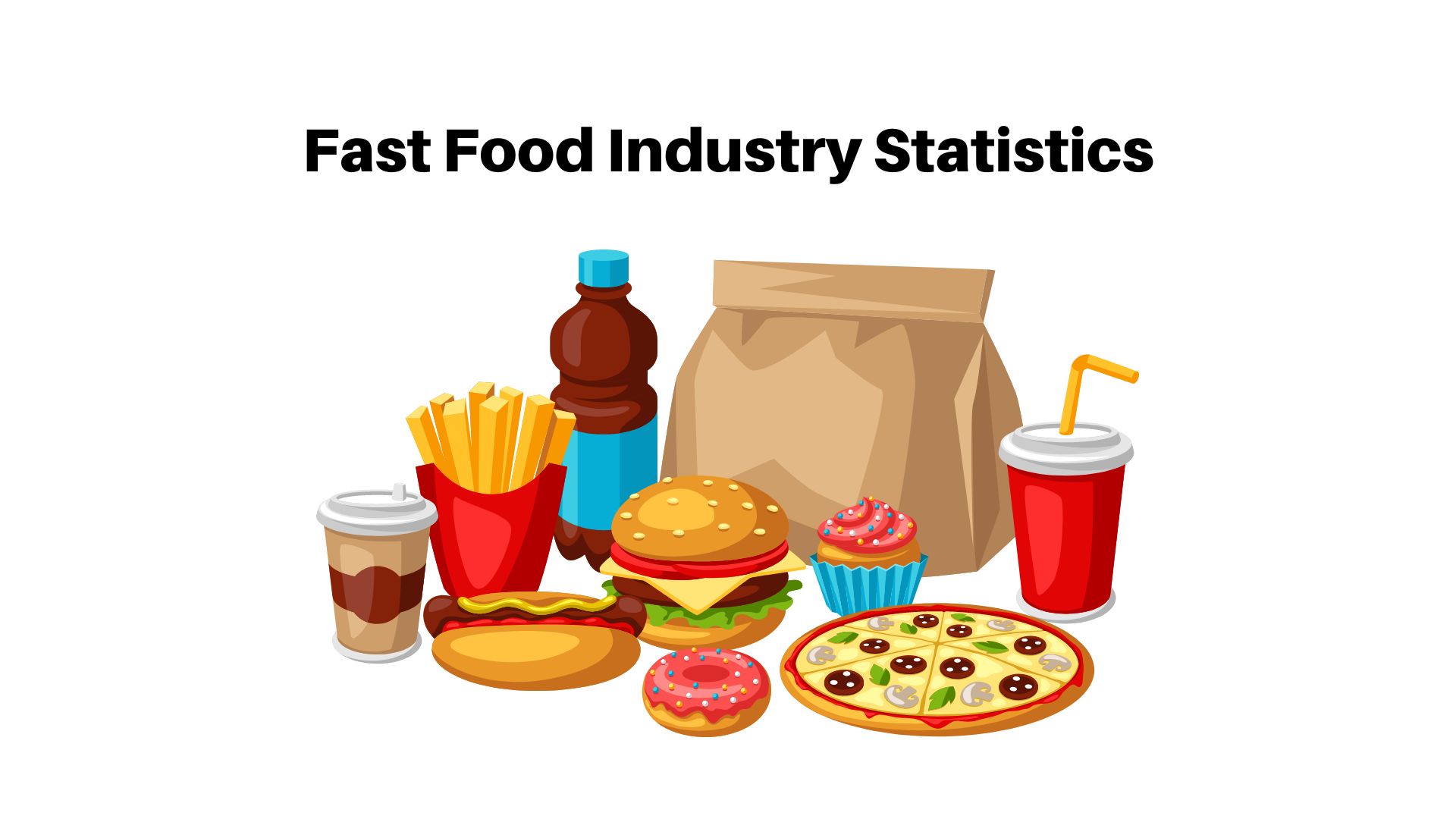
Page Contents
- Introduction
- Editor’s Choice
- Facts About The Fast Food Industry
- What Refers To Fast Food?
- General Fast Food Industry Statistics
- By Region
- By Product
- By Company
- By Body Type
- By Mealtime
- By Demographic
- By Market Share
- By Number Of Fast-Food Companies Locations
- Trends in the Fast Food Industry
- Recent Development In the Fast Food Industry
- Conclusion
Introduction
Fast Food Industry Statistics: The fast food industry is a significant player in the global economy, with staggering numbers reflecting its widespread impact. In 2024, the industry's market value reached an impressive USD 957 billion, showcasing its immense scale and influence. This figure represents a substantial increase from previous years, highlighting the industry's continuous growth trajectory. With a CAGR of 4.3% projected from 2021 to 2026, the fast food sector demonstrates resilience and sustained demand, making it a lucrative market for investors and stakeholders alike.
Consumer preferences also play a pivotal role in shaping the fast food landscape. Approximately 45% of consumers in the United States dine at fast food restaurants at least once a week, emphasizing the industry's popularity and consumer appeal. Moreover, the convenience factor remains a key driver, with 70% of consumers citing convenience as the primary reason for choosing fast food options. This underscores the importance of accessibility and efficiency in catering to evolving consumer needs and preferences.
Additionally, the fast food industry is known for its competitive pricing strategies and value offerings. With the average meal costing around USD 7.50, fast-food establishments provide affordable dining options for budget-conscious consumers. Furthermore, technological advancements and digital innovations have revolutionized the industry, with over 60% of fast food orders now being placed online or via mobile apps. This shift towards digital channels reflects changing consumer behaviors and the industry's adaptation to emerging trends in the digital space.
Editor’s Choice
- As of November 2022, there are approximately 796,769 businesses in the fast-food industry globally.
- The age group of 20 to 39 years constitutes the highest consumers of fast food worldwide.
- In the United States, 84 million people consume fast food daily, with over 200,000 fast food outlets.
- Consumers worldwide devour around 50 billion burgers annually.
- North America commands the largest market share for fast food, accounting for 28% as of 2021.
- 4% of global consumers report never consuming fast food.
- By 2029, the Asian/Latin American food segment is projected to grow at a CAGR of 3.4%.
- Burgers/sandwiches held a market share of approximately 43% in 2021.
- In the US, burger sales topped the fast-food segment at USD 92.2 billion in 2021.
- The US fast food industry boasts a market size of USD 331.41 billion in 2022, with an expected CAGR of 5.1% from 2020-2027.
- Globally, the fast food industry's value surpasses USD 907 billion as of 2023.
- 37% of Americans, or 50 million people, consume fast food daily.
- The average primary meal portion size increased by 124% between 1986 and 2016.
- Yum Brands, the parent company of several fast-food chains, is valued at USD 35.7 billion globally.
- The online food delivery market reached a worth of USD 151.526 billion in 2021.
- McDonald's was the world's most valuable food brand in 2020, with 85% of Americans eating from it at least once a year.
You May Also Like To Read
- Burger King Statistics
- Energy Drink Statistics
- Dietary Supplements Statistics
- Gluten-Free Diet Statistics
- Vegan Statistics
- Wendy’s Statistics
- McDonald’s Statistics
- Online Food Ordering Statistics
- Soft Drink Sales Statistics
- Pizza Hut Statistics
- Starbucks Statistics
Facts About The Fast Food Industry
- The global fast-food industry comprises approximately 796,769 businesses as of November 2022.
- Consumers aged 20 to 39 years are the largest demographic consuming fast food.
- In the United States, over 84 million people consume fast food daily, supported by a network of 200,000+ fast food outlets.
- Worldwide, approximately 50 billion burgers are consumed annually.
- North America leads the global market share for fast food, accounting for 28% as of 2021.
- Despite its popularity, 4% of consumers globally report never consuming fast food.
- By 2029, the Asian/Latin American food segment is projected to grow at a CAGR of 3.4%.
- Burgers and sandwiches represent around 43% of the fast food market share.
- In the US, burger sales alone amounted to USD 92.2 billion in 2021.
- The US fast food industry is valued at USD 331.41 billion as of 2022, with an expected CAGR of 5.1% from 2020-2027.
- Globally, the fast food industry's value exceeds USD 907 billion as of 2023.
- 37% of Americans, or 50 million individuals, consume fast food daily.
- Over the years, the average primary meal portion size has increased significantly.
- Yum Brands, a major player in the fast food industry, boasts a global valuation of USD 35.7 billion.
- The online food delivery market reached USD 151.526 billion in 2021.
- McDonald's remains the world's most valuable food brand, with 85% of Americans patronizing it at least once annually.
What Refers To Fast Food?
Fast food is a kind of food type which is mostly pre-cooked and can be served quickly. Various types of fast food include fried chicken, tacos, burgers, hamburgers, sandwiches, bakery products, milkshakes, noodles, and ice cream. Normally, consuming these items regularly is not good for health. People who eat fast food on an occasional level are leading a fit and healthy life. Over the food, since the lifestyle of people has changed, the market is growing speedily more specifically in the United States of America. Fast food is sometimes called takeaway food because it can be taken away from the outlets with ease.
General Fast Food Industry Statistics
- 21% of the millennials choose fast food items by seeing the post on social media or any other photos.
- $881.1 billion is the global fast-food restaurant market size as of 2022.
- According to the fast-food industry statistics, the growth of the fast-food industry in the year 2022 is 2.2%.
- The global fast-food industry ranks second in the list of global hotels and restaurants industry.
- Around the globe, there are around 7,96,769 businesses in the fast-food industry as of November 2022 as studied by the fast-food industry statistics.
- In the year 2021, quick-service restaurants captured 43% of the overall fast-food industry market.
- By the year 2029, the Asian/Latin American food segment is forecasted to grow at a CAGR of 3.4%.
- Majority of the Americans eat fast food at least 1 to 3 times every week.
- Moreover, fast food industry statistics say that people from the age group of 20 years to 39 years eat fast food more than any other age group.
- On average American households spend around 10% of their income per year on fast food.
- Males are more fast-food consumers than females.
- People with regular income eat more fast food than those who earn less or no income at all.
- According to the Fast-food industry statistics, American households together eat fast food in restaurants at least once a week resulting in 83%.
- People tend to eat fast food more during noon time.
- Considering the person, the habit of eating fast food is studied to increase by 2.2% every year.
- 59% of young adults are regular consumers of fast-food restaurants.
- 20% of the population in the United States of America eats fast food in their cars.
- The market size of the quick service restaurant industry around the world in the year 2021 was USD 797.68 billion whereas it reached USD 826.89 billion in the year 2022.
- According to Fast food industry statistics, consumers eat around 50 billion burgers every year.
- As per the fast-food industry statistics, 4% of people around the globe stated that they never consumed fast food.
- 70% of people around the globe eat fast food once a week.
- The United States of America has over 2,00,000 fast food industry outlets as of today.
- On average the overall fast-food consumers spend around USD 200 billion on the fast-food industry every year in the United States of America.
- Americans on average as stated by Fast food industry statistics, spend around USD 70,500 on fast food in their lifetime.
- 80% of the fast food in McDonald’s is consumed by children.
- 30% of the population is more likely to eat advertised fast food on television.
- As per the Fast-food industry statistics, 20% of people say that consuming fast food is good for their health, whereas 76% of people say it is bad for their health.
- There are over 12 million employees who are working in the fast-food industry.
By Region
- The United States of America has the highest number of people consuming fast food every day resulting in 84 million. The top fast-food items preferred by these people are pizza, wings, ice cream, French fries, various beverages, and sandwiches.
- France ranks second in the list of top countries with the highest number of fast-food consumers around the world. Residents in France prefer to eat from Subway.
- Canada and the United Kingdom rank third and fourth respectively.
- In Canada, people love Tim Horton’s, McDonald’s, and various bakery items.
- South Korea ranks fifth for having the maximum number of people consuming fast food.
As seen in the above chart, North America has the largest market share for fast food as of 2021 resulting in 28% as compared to Asia Pacific, Latin America, Europe, and Middle East, and Africa.
By Product

(Image Source: Brandongaille)
- People who eat fast food prefer fries by 37% being the highest of all.
- Whereas burgers are preferred by 34% of people around the globe.
- Soft drinks and coffee are preferred by 6% each.
- Whereas various types of Shakes have a preferred rate of 11%.
- In the year 2021, the market share of burgers/sandwiches was around 43%.
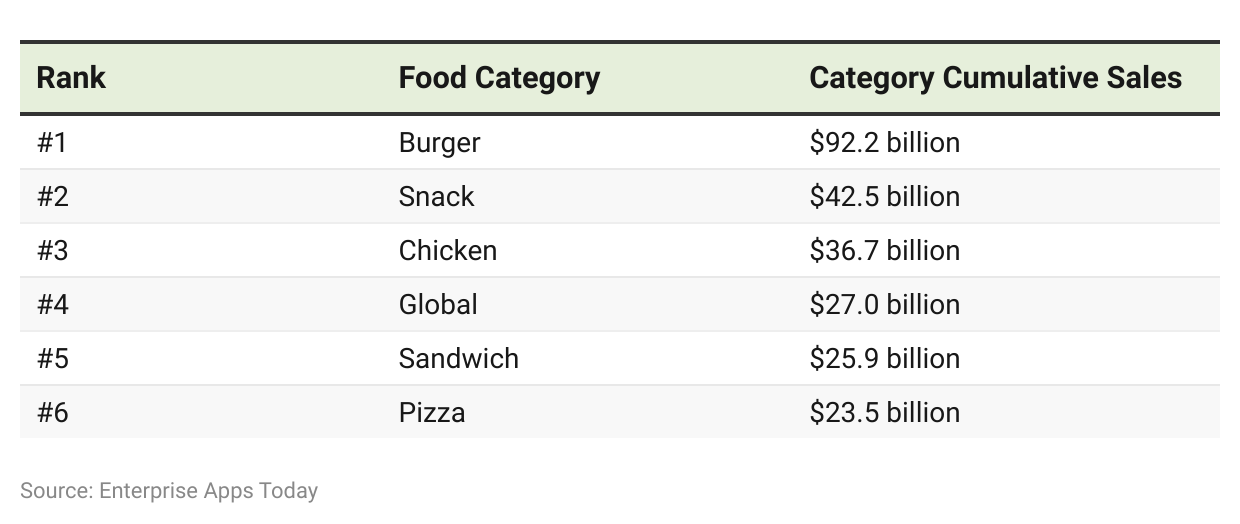
(Reference: Visual Capitalist)
- As in the American segment, in the year 2021, the burger was the highest fast-food sale at USD 92.2 billion, followed by various snacks at USD 42.5 billion.
- Various chicken items and global fast-food items captured USD 36.7 billion and 27.0 billion respectively.
- Sandwich earned a cumulative sale of USD 25.9 billion, and Pizza captured USD 23.5 billion in the year 2021
By Company
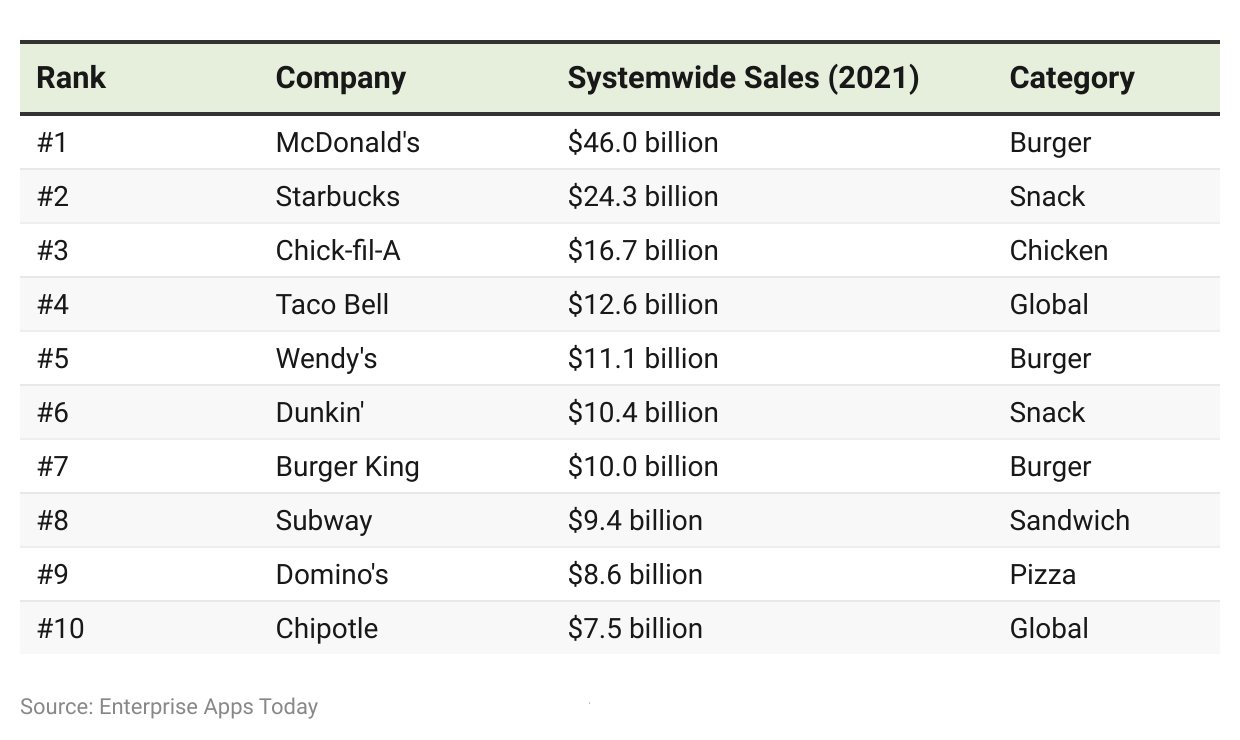
- As of 2021, McDonald’s has ranked number one for maximum sale of burgers with USD 46.0 million in sales, followed by Starbucks’ snacks item with 24.3 million worldwide sales.
- Similarly, Chick-fil-A’s chicken, Taco Bell’s overall items, Wendy’s Burger, Dunkin’s snack, and Burger King’s burger also captured USD 16.7 billion, USD 12.6 billion, USD 11.1 billion, USD 10.4 billion, and USD 10 billions of worldwide sale respectively.
- Accordingly, Sandwich from Subway, Pizza from Domino’s, and Global items from Chipotle made their way to USD 9.4 billion, USD 8.6 billion, and USD 7.5 billion.
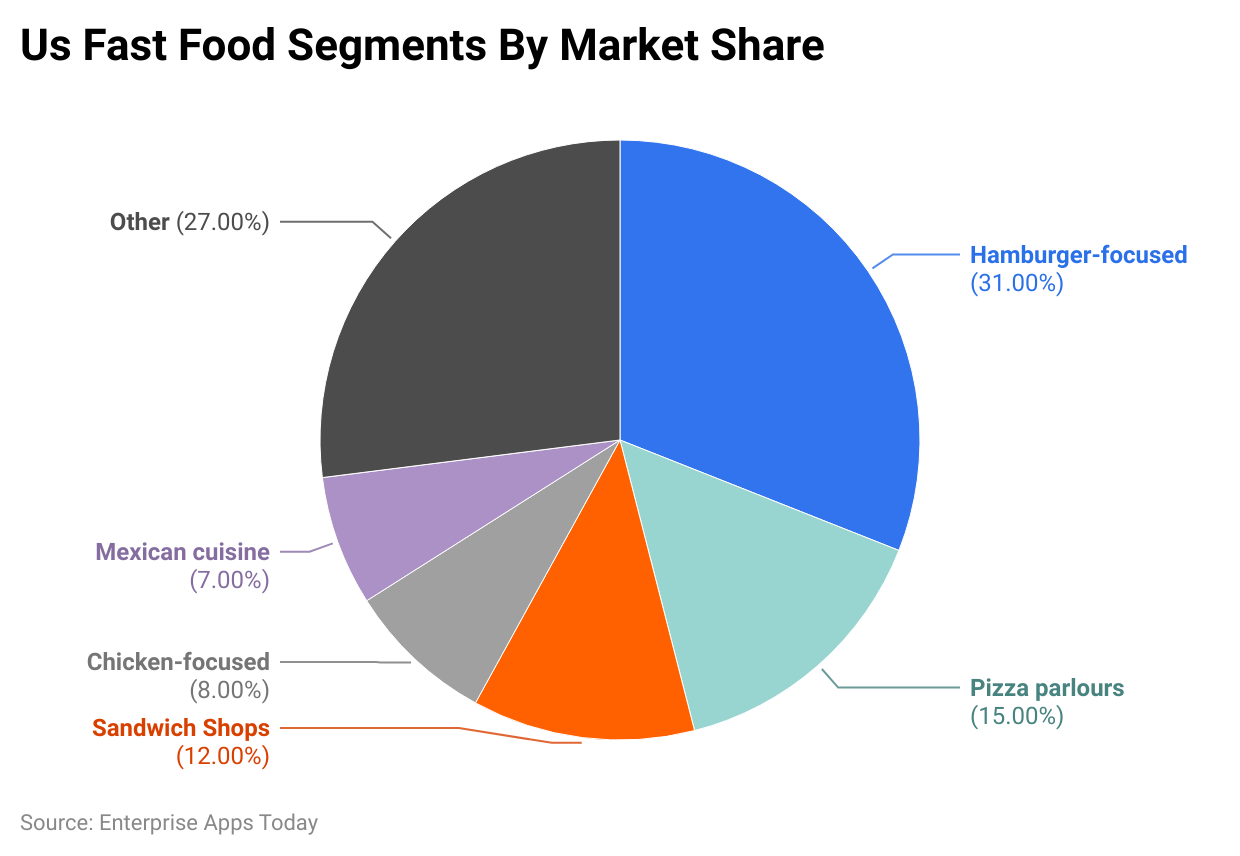
- The highest market share in food by type is Hamburger resulting in 31% in the United States of America.
- Whereas Pizza parlors have 15% of the share in the food segments.
- Sandwich outlets are 12%, Chicken-based food shops are 8%, and Mexican cuisine shops are around 7% in the American market.
- Other fast-food articles are around 27% in the US market.
By Body Type
#1. Skinny
- 55% of People with skinny body types have eaten fast food 1 or 2 times in the past 3 months.
- Whereas 27% of the skinny people ate 3 to 4 times over the last 3 months.
- Similarly, 9% of the people ate 5 to 6 times in 3 months, 3% of the people ate more than 7 times and 6% of the skinny people haven’t at all eaten fast food over the last 3 months.
#2. Fit
- 47% of People with fit body type, prefer to eat fast to 1 to 2 times for 3 months.
- 35% of the people ate 3 to 4 times in 3 months.
- Accordingly, 8% of the people preferred to eat fast food 5 to 6 times, 5% ate more than 7 times, and 6% of the people did not eat fast food.
#3. Overweight
- On the other hand, 53% of overweight people ate fast food 3 to 4 times in the past 3 months.
- 16% of the people preferred to eat 5 to 6 times in a similar period.
- 21% of the people chose to eat more than 7 times and 11% of people chose to eat fast food only 1 to 2 times in a quarter.
By Mealtime
- Fast food industry statistics say that 22.7% of people from around the globe, eat fast food during breakfast time.
- 7% of the consumers prefer to eat fast food during lunch.
- Whereas 22.6% and 42% of the people eat it during snack time and dinner time respectively.
By Demographic
- 38% of the male and 35.4% of the female are fast food consumers according to Fast food industry statistics.
- 6% of white people eat fast food whereas the highest percentage of fast-food consumers is the black population resulting in 42.4% from around the globe.
- Asian population consuming fast food resulted in 30.6% whereas, the Hispanic population recorded 35.5% in overall fast-food consumers.
- Considering the age group, 44.9% of the people from the age group of 20 years to 39 years have recorded the highest percentage of fast food consumers.
- There is 37.7% population from the age group of 40 years to 59 years.
- Moreover, people aged 60 years and above have contributed around 24.1% to the list of fast-food consumers.
- 7% of the people consume fast food from the lower class population.
- Middle-class and upper-class populations contribute to fast food consumption by 36.4% and 42% respectively.
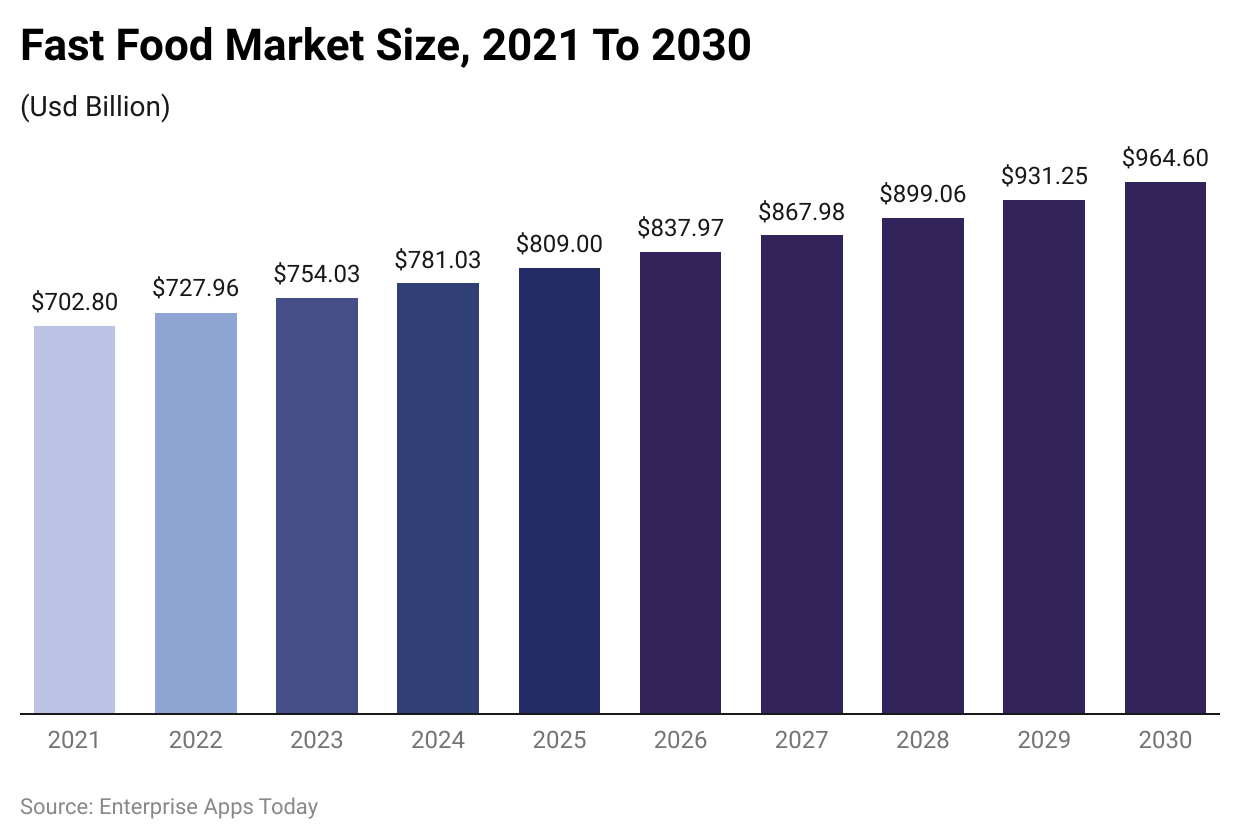
- As seen in the above chart, the global fast-food industry statistics show the overall increasing growth in the global market.
- As of the year 2021, the market size was valued at USD 702.80 billion, which increased to USD 727.96 billion in the year 2022.
- It is expected that it will reach USD 754.03 billion in the year 2023, to USD 781.03 billion by the year 2024.
- In the coming six years (2025, 2026, 2027, 2028, 2029, and 2030) the industry will see a growing market size of USD 809 billion, USD 837.97 billion, USD 867.98 billion, USD 899.06 billion, USD 931.25 billion and USD 964.6 billion with respective years.
By Number Of Fast-Food Companies Locations
| Company | Total Locations |
|---|---|
| Subway | 24,798 |
| Starbucks | 14,825 |
| McDonald's | 13,914 |
| Dunkin' | 9,419 |
| Pizza Hut | 7,456 |
| Burger King | 7,327 |
| Wendy's | 6,711 |
| Taco Bell | 6,588 |
| Domino's | 5,876 |
| Dairy Queen | 4,406 |
(source: ZIPPIA)
- As per the above chart, in the United States of America, there are 24,798 outlets of Subway, whereas Starbucks has 14,825.
- Similarly, various fast food companies have a different number of outlets as follows, Macdonald’s (13,914), Dunkin’ (9,419), Pizza Hut (7,456), Burger King (7,327), Wendy’s (6,711), Taco Bell (6,588), Domino’s (5,876), and Daily queen (4,406).
Trends in the Fast Food Industry
- Healthier Options: There's a rising trend toward healthier fast food options, including plant-based alternatives and menu items with reduced calories, sodium, and saturated fats.
- Digital Transformation: Fast food chains are increasingly investing in digital technologies such as mobile apps, self-ordering kiosks, and delivery services to enhance convenience and customer experience.
- Global Expansion: Fast food brands are expanding globally, particularly in emerging markets like Asia and Latin America, where there's a growing appetite for Western-style fast food.
- Sustainability Initiatives: Many fast food chains are implementing sustainability initiatives to reduce their environmental footprint, such as using eco-friendly packaging, sourcing locally, and minimizing food waste.
- Customization and Personalization: Consumers are seeking more customizable and personalized fast food options, leading to the introduction of build-your-own menus and customizable meal combinations.
- Focus on Transparency: There's a growing demand for transparency in ingredients and sourcing practices, prompting fast food companies to provide more information about the nutritional content and origins of their menu items.
- Innovative Marketing Strategies: Fast food brands are adopting innovative marketing strategies, including influencer partnerships, social media campaigns, and experiential marketing events, to engage with younger consumers and stay relevant in a competitive market.
- Diversification of Menu: Fast food chains are diversifying their menus to cater to changing consumer preferences and dietary restrictions, offering options such as vegetarian, vegan, gluten-free, and low-carb alternatives.
- Emphasis on Convenience: Convenience remains a key trend in the fast food industry, with brands focusing on speed of service, drive-thru efficiency, and seamless ordering and payment processes to meet the demands of busy consumers.
Recent Development In the Fast Food Industry
- Plant-Based Options: Many fast food chains have recently introduced or expanded their plant-based menu offerings in response to growing consumer demand for healthier and more sustainable food choices.
- Digital Ordering Platforms: There's been a surge in the adoption of digital ordering platforms, including mobile apps and online delivery services, as fast food companies continue to prioritize contactless and convenient ordering methods.
- Focus on Delivery: With the rise of food delivery services, fast food chains are increasingly investing in delivery infrastructure and partnerships to reach a wider customer base and capitalize on the growing trend of ordering food from home.
- Health and Wellness Initiatives: Some fast food brands are rolling out health and wellness initiatives, such as offering nutrition information and promoting balanced meal options, to address concerns about the nutritional quality of their menu offerings.
- Partnerships and Collaborations: Fast food companies are entering into strategic partnerships and collaborations with other brands, celebrities, and influencers to create buzzworthy menu items and attract new customers.
- Sustainability Efforts: Many fast food chains are implementing sustainability efforts, such as reducing packaging waste, sourcing ingredients ethically, and investing in renewable energy, to align with consumer expectations and corporate social responsibility goals.
Conclusion
All of us love fast food, and we usually eat such food once a month. Change in the pattern of food is good for health unless the eating habit is under control. Fast food is increasing its trend because of the fast-paced generation. These types of food are easily eatable with one hand, so the other hand is used for multi-tasking, just like working in the office and eating a burger or fries simultaneously. This fast-food industry has become a billion-dollar industry.
But to be honest, habits of eating are changing, as well as lifestyle is changing with no exercise in daily life. This is the reason, the younger generation is becoming potato couches, with obscenity and low levels of flexibility in the body. It is always recommended to eat healthily and stay healthy for an improved lifestyle.
Sources
FAQ.
It is okay to eat fast food once a month with limited food items.
No. If you have any health conditions, you are not advised to eat any kind of fast food.
Yes, soft drinks include a high level of sugar, which can lead to diabetes and obesity followed by heath deceases.
No, eating fried food on a regular level also causes heart problems because such food is full of oil and excessive consumption of oil is not good for health.

Barry is a lover of everything technology. Figuring out how the software works and creating content to shed more light on the value it offers users is his favorite pastime. When not evaluating apps or programs, he's busy trying out new healthy recipes, doing yoga, meditating, or taking nature walks with his little one.